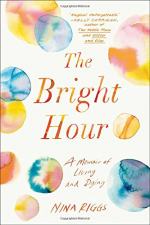|
This section contains 482 words (approx. 2 pages at 400 words per page) |

|
The Bright Hour Summary & Study Guide Description
The Bright Hour Summary & Study Guide includes comprehensive information and analysis to help you understand the book. This study guide contains the following sections:
This detailed literature summary also contains Topics for Discussion on The Bright Hour by Riggs, Nina.
The following version of this book was used to create this study guide: Riggs, Nina. The Bright Hour. Simon and Schuster. New York, NY. First hardcover edition, June 2017. The narrative unfolds in first-person, present-tense narration, drawing the reader into the thoughts, insights, and experiences of the author as she moves through the final year of her life.
The overall structure of the book follows a pattern similar to that of an experience of having cancer, an experience defined by stages (or degrees of severity): Stage One is the least serious; Stage Four suggests imminent death. For the author, Stage One of both her experience with cancer and her memoir of that experience begin with the discovery of “a small spot” of cancer in one of her breasts; descriptions of initial bouts of chemotherapy; and additional descriptions of activities the author does to keep herself busy and preoccupied.
Stage Two begins with the author’s discovery that the initial small spot of cancer has grown and multiplied. She undergoes more chemotherapy, and also undergoes a radical mastectomy (the surgical removal of the afflicted breast). In her narration and contemplation of these experiences and circumstances, she continues to find parallels between her own experiences and those of her mother, as well as parallels between her own insights and those of her ancestor, renowned poet/philosopher Ralph Waldo Emerson.
Stage Three of the author’s fight with cancer, and her narrative of that fight, begins with her narration of her mother’s death, and of how on some level, she believes she is rehearsing her own. She writes of how, as her family comes to grips with the new experience of emptiness in their lives, she started to find new ways of living, of finding happiness, and of connecting with both her mother and her father. Meanwhile, she continues to undergo treatment for her own cancer, and to find parallels between her experiences and those of writers she admires, including Emerson and French philosopher Michel de Montaigne.
Finally, Stage Four follows the author as she experiences cancer moving rapidly through her body, causing one of the vertebrae in her spine to break and making another surgery necessary. Meanwhile, the author and her husband manage to take a long-delayed trip to Paris, where they encounter several ways in which, in spite of the many years since their previous visit, things like art galleries, restaurants, and the atmosphere of the city have not changed. Eventually, the author’s condition deteriorates to the point where her function around the home is minimal, but she nevertheless continues to play as active a role as possible in the lives of her children, and in her own treatment.
In an afterword, the author’s husband describes the final weeks, days, and hours of the author’s life, concluding with the narrative of her death shortly before sunrise on February 26, 2017.
Read more from the Study Guide
|
This section contains 482 words (approx. 2 pages at 400 words per page) |

|



